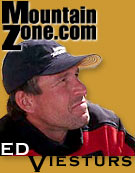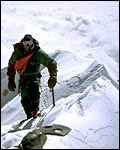
Ed Viesturs: A Matter of Judgment
'No Summit is Worth Dying For'
Wednesday, July 24, 2002
 | ||
| Makalu, 1995 Viesturs Gallery | ||
"It just goes to show that the decision to retreat is often wise," Viesturs said. "If you turn around, you can always come back to try again later. That's something you might not be able to do if you go for it and get caught in an avalanche."
On Shishapangma in 2001, Gustafsson and Viesturs put in only two camps on their 16-day climb to the summit, taking that length of time to acclimate for the final push to the summit.
"Incredibly," said Viesturs, "we had this big, beautiful mountain completely to ourselves during the climb. That's rare these days, and it makes for a very special experience."
This spring, a year after the Shishapangma summit, Viesturs was making his second attempt on Annapurna, located in the Nepal Himalaya in north-central Nepal. At 8,091 meters (26,545 feet), Annapurna I is the 10th highest mountain peak in the world.
| "The upper
part of the mountain was completely blocked by ice cliffs. To travel
underneath that stuff day in and day out was insane...." |
|||||
"The objective danger was off the scale," Viesturs recalled. "The upper part of the mountain was completely blocked by ice cliffs. To travel underneath that stuff day in and day out was insane. We spent a lot of time, and looked at many different routes, but nothing was acceptable to any of us. We came home."
But when Viesturs made the decision that year to leave Annapurna, noting that the north side seemed to offer no viable route, he resolved to look at other possibilities for climbing the mountain. An accidental meeting in Tibet last year led to this year's attempt on the south side of the peak.
"In spring of 2001," Viesturs said, "I bumped into a French climber, Christian Trommsdorff, who knew of me and what I was trying to do. Trommsdorff told me about a route he found on the south side that he thought might offer a way up without the overwhelming objective dangers on the north side." Viesturs was optimistic.
"It's a long, hard, strenuous way to the top," Viesturs told MountainZone.com, "but for me, it seemed a better compromise. The trade-off is this: there is less objective danger, but you have to spend more time in the death zone (26,000+'). It's like climbing two or three high mountains, but I'll take that option over objective danger, because I'm more in control."
So last April, Viesturs, Gustafsson, Jean-Christophe LaFaille and a group of Basque climbers traveled to Annapurna to see if the route Trommsdorff had been on might go. (See www.edviesturs.com for complete dispatches). But after weeks working on the long route, the climbers ran into conditions that Viesturs felt were unsafe.
"After spending a day camped high on the route," Viesturs said, "both Veikka and I decided not to continue further. The face of Roc Noir, which is an 800-foot snow face of about 45 degrees, is very prone to avalanche. That day, it was a textbook avalanche slope. We felt, in our own evaluation, that the level of risk was unacceptable. It's a tough call to make when you spend four or five weeks on an expedition like this, and you get so close, and then are faced with an assessment like that. But I've done it before, and I may have to do it again. When it feels bad and my gut instinct is telling me it is bad, then I know it's bad."
Viesturs and Gustafsson decided to retreat, while LaFaille and Basque climber Alberto Inurrategi continued up. They reached the summit two days later.
"We were elated that JC and Alberto reached the top," Viesturs said. "They were willing to accept a much higher level of risk that we were. It comes down to a personal decision: what's your level of acceptable risk? This is what it's all about. How do you make those choices? How do you make those decisions? What pressures are there? I think for everybody, it's a tough call.
"But as you get older, you get smarter, and it gets easier to make those decisions. You're able to withstand the external pressure better. You can't be swayed by what other people are thinking or doing. You can't let others decide, because it's your life. You have to decide on your own."
Viesturs added that he is fortunate with the lack of pressure he gets from his sponsors, his friends and those close to him. That situation helps him make smart decisions.
"My sponsors have been totally supportive of my climbing style," he said. "When I got back they're like, 'Way to go. We're glad that you decided what you decided to do, that's why we want to be hooked up with you.' So that's very positive."
In the end, Viesturs says, if you're going to do something as dangerous as climbing 8,000-meter peaks, you'd better be comfortable making your own decisions.
"The trick," Viesturs says, "is to be mature enough to be totally happy with what you decide. You only get one chance to make the call."
— Peter Potterfield, MountainZone.com Staff
